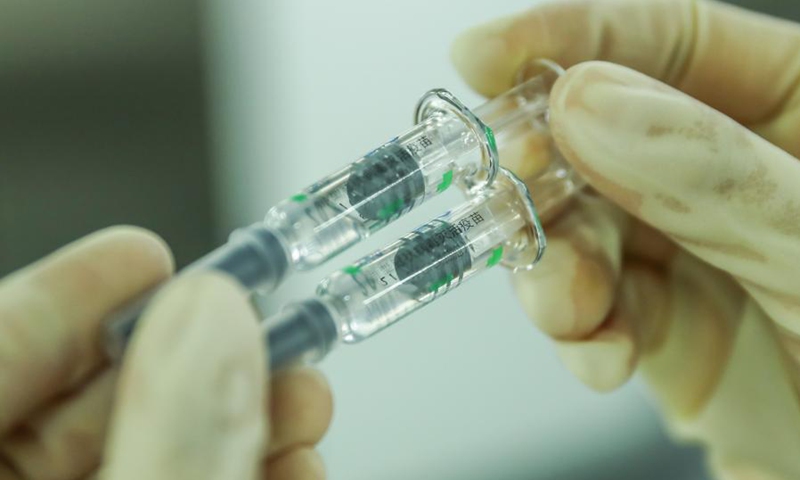
A staff member checks the packaging quality of COVID-19 inactivated vaccine products at a packaging plant of the Beijing Biological Products Institute Co., Ltd. in Beijing, capital of China, Dec. 25, 2020. Photo: Xinhua
China on Thursday announced that it has granted market approval attached with conditions for its first homemade COVID-19 vaccine, which was developed by Sinopharm, marking a monumental step in the battle against the pandemic that has killed 1.79 million globally.
The inactivated vaccine developed by Beijing Biological Products Institute under Sinopharm's subsidiary China National Biotec Group (CNBG), got official authorization from China's National Medical Products Administration on Wednesday,Chen Shifei, deputy head of the National Medical Products Administration, said at Thursday's press conference.
The move came one day after the institute announced that the vaccine showed 79.34 percent efficacy and a 99.52 percent antibody positive conversion rate, according to interim results of the Phase III clinical trials.
The results are better than the 50 percent standard of the World Health Organization (WHO) and Chinese authorities, according to the institute. The vaccine also showed a good safety level, its producers noted.
A vaccine has to undergo strict review by each country's national drug administration before being authorized for public use. All data and processes are reviewed by professional third-party committees, CNBG's chairman Yang Xiaoming told the Global Times in a recent exclusive interview.
Yang was inoculated with a CNBG vaccine in March with hundreds of his colleagues. He said they had tested the level of antibodies six months after vaccination and the results were good.
Yang noted that data on safety and efficacy collected so far in the Phase III clinical trials is better than expected
Reported side effects of the vaccines are also milder than expected, Yang said. The side effects of CNBG's inactivated vaccines include aches or redness at the injection site, fever, muscular soreness, sickness and headache.
A representative of Sinopharm told the Global Times on Wednesday that the interim results are mainly based on data from trials conducted in the United Arab Emirates, the vaccine's largest test base. The Chinese regulator uses a very rigorous standard - stronger even than the international criteria - in reviewing the number of confirmed infected cases in the double-blind placebo-controlled trials for understanding the efficacy of the vaccine.
The Beijing institute's vaccine was approved in the UAE and Bahrain earlier this month.
Sinopharm's two inactivated vaccines have been administered to nearly 1 million people for emergency use and no serious adverse reactions have been reported. About 70,000 volunteers have participated in the phase-III clinical trials in more than 10 countries.
So far, at least 10 provinces in China, including East China's Jiangsu Province and South China's Guangdong Province, have officially announced a vaccination plan for local residents.
To form an immunology barrier it requires at least 700 million Chinese residents to be vaccinated, which means at least 1.4 billion doses, Yang said.
Normally there would only be 500-700 million doses of vaccines available on the Chinese market every year, Yang said, noting that it would be a big challenge for China to conduct mass vaccination in such a short time.
According to Yang, CNBG's production capacity of COVID-19 inactivated vaccines has reached 120 million doses by the end of the year and it will expand to one billion doses per year in 2021.
Yang noted that China has established a complete cold-chain industry for vaccine delivery. The only potential problem may lie in the imbalance between different areas such as developed coastal areas and central and western areas that are comparatively less developed.
Tao Lina, a vaccine expert in Shanghai, said that the approval demonstrated that China has created a "miracle" by creating a vaccine within one year.
Pfizer and Moderna have announced 95 percent efficacy for their mRNA vaccines, which was beyond predictions and drove up the public's expectation for Chinese inactivated vaccines.
Tao noted that despite the high efficacy, the US mRNA vaccines have shown more side effects as well as acute allergy occurrences. The mRNA vaccines also have more strict requirements for transportation.
Tao suggested that the inactivated and mRNA vaccines can both help human beings to resist the novel coronavirus. But both are early-stage products and more improved ones are expected, which will offer more balance between efficacy, safety and transportation requirements.




